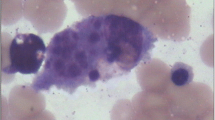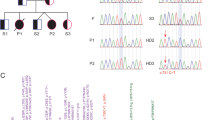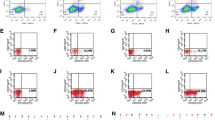Abstract
We describe here a novel c.137 + 5G > A intronic mutation in the SH2D1A gene of the signaling lymphocyte activation molecule (SLAM)-associated protein (SAP) in association with Epstein-Barr virus (EBV)-induced fatal infectious mononucleosis (FIM) in an 8-year-old male patient and his 3-year-old step brother. The mother and the maternal grandmother of the boys are healthy and heterozygous for this sequence variant. Genetic sequencing of blood-cell-derived cDNA in the younger patient revealed a 22 bp deletion in the SH2D1A cDNA. Immunoblot and flow cytometry analysis performed in this younger patient showed the lack of SAP protein expression in peripheral blood lymphocytes. These data suggest that the novel c.137 + 5G > A mutation results in loss of function of SAP protein and leads to typical X-linked lymphoproliferative disease phenotype. We propose that intron 1 and the c.137 + 5G may be the most frequent intronic hot spot for SH2D1A splicing mutation.






Similar content being viewed by others
References
Filipovich AH, Zhang K, Snow AL, Marsh RA. X-linked lymphoproliferative syndromes: brothers or distant cousins? Blood. 2010;116:3398–408.
Dupre L, Andolfi G, Tangye SG, Clementi R, Locatelli F, Arico M, et al. SAP controls the cytolytic activity of CD8 T cells against EBV-infected cells. Blood. 2005;105:4383–9.
Purtilo DT, Cassel CK, Yang JP, Harper R. X-linked recessive progressive combined variable immunodeficiency (Duncan’s disease). Lancet. 1975;7913:935–40.
Seemayer TA, Gross TG, Egeler RM, Pirruccello SJ, Davis JR, Kelly CM, et al. X-linked lymphoproliferative disease: twenty-five years after the discovery. Pediatr Res. 1995;38:471–8.
Sümegi J, Seemayer TA, Huang D, Davis JR, Morra M, Gross TG, et al. A spectrum of mutations in SH2D1A that causes X-linked lymphoproliferative disease and other Epstein-Barr virus-associated illnesses. Leuk Lymphoma. 2002;43:1189–201.
Ma CS, Hare NJ, Nichols KE, Dupré L, Andolfi G, Roncarolo MG, et al. Impaired humoral immunity in X-linked lymphoproliferative disease is associated with defective IL-10 production by CD4+ T cells. J Clin Invest. 2005;115:1049–59.
Parolini S, Bottino C, Falco M, Augugliaro R, Giliani S, Franceschini R, et al. X-linked lymphoproliferative disease. 2B4 molecules displaying inhibitory rather than activating function are responsible for the inability of natural killer cells to kill Epstein-Barr virus-infected cells. J Exp Med. 2000;192:337–46.
Cuss AK, Avery DT, Cannons JL, Yu LJ, Nichols KE, Shaw PJ, et al. Expansion of functionally immature transitional B cells is associated with human-immunodeficient states characterized by impaired humoral immunity. J Immunol. 2006;176:1506–16.
Chaganti S, Ma CS, Bell AI, Croom-Carter D, Hislop AD, Tangye SG, et al. Epstein-Barr virus persistence in the absence of conventional memory B cells: IgM + IgD + CD27+ B cells harbor the virus in X-linked lymphoproliferative disease patients. Blood. 2008;112:672–9.
Recher M, Fried AJ, Massaad MJ, Kim HY, Rizzini M, Frugoni F, et al. Intronic SH2D1A mutation with impaired SAP expression and agammaglobulinemia. Clin Immunol. 2012;146:84–9.
Latour S, Veillette A. Molecular and immunological basis of X-linked lymphoproliferative disease. Immunol Rev. 2003;192:212–24.
Nichols KE, Harkin DP, Levitz S, Krainer M, Kolquist KA, Genovese C, et al. Inactivating mutations in an SH2 domain-encoding gene in X-linked lymphoproliferative syndrome. Proc Natl Acad Sci U S A. 1998;95:13765–70.
Pachlopnik Schmid J, Canioni D, Moshous D, Touzot F, Mahlaoui N, Hauck F, et al. Clinical similarities and differences of patients with X-linked lymphoproliferative syndrome type 1 (XLP-1/SAP deficiency) versus type 2 (XLP-2/XIAP deficiency). Blood. 2011;117:1522–9.
Sumazaki R, Kanegane H, Osaki M, Fukushima T, Tsuchida M, Matsukura H, et al. SH2D1A mutations in Japanese males with severe Epstein-Barr virus–associated illnesses. Blood. 2001;98:1268–70.
Brandau O, Schuster V, Weiss M, Hellebrand H, Fink FM, Kreczy A, et al. Epstein-Barr virus-negative boys with non-Hodgkin lymphoma are mutated in the SH2D1A gene, as are patients with X-linked lymphoproliferative disease (XLP). Hum Mol Genet. 1999;8:2407–13.
Sümegi J, Huang D, Lányi A, Davis JD, Seemayer TA, Maeda A, et al. Correlation of mutations of the SH2D1A gene and epstein-barr virus infection with clinical phenotype and outcome in X-linked lymphoproliferative disease. Blood. 2000;96:3118–25.
Sayos J, Wu C, Morra M, Wang N, Zhang X, Allen D, et al. The X-linked lymphoproliferative-disease gene product SAP regulates signals induced through the co-receptor SLAM. Nat. 1998;395:462–9.
Tabata Y, Villanueva J, Lee SM, Zhang K, Kanegane H, Miyawaki T, et al. Rapid detection of intracellular SH2D1A protein in cytotoxic lymphocytes from patients with X-linked lymphoproliferative disease and their family members. Blood. 2005;105:3066–71.
Debeljak M, Podkrajsek KT, Aplenc R, Jazbec J. X-linked lymphoproliferative disease with a novel SH2D1A gene mutation. Pediatr Blood Cancer. 2008;50:187.
Coffey AJ, Brooksbank RA, Brandau O, Oohashi T, Howell GR, Bye JM, et al. Host response to EBV infection in X-linked lymphoproliferative disease results from mutations in an SH2-domain encoding gene. Nat Genet. 1998;20:129–35.
Yin L, Ferrand V, Lavoué MF, Hayoz D, Philippe N, Souillet G, et al. SH2D1A mutation analysis for diagnosis of XLP in typical and atypical patients. Hum Genet. 1999;105:501–5.
Erdős M, Uzvölgyi E, Nemes Z, Török O, Rákóczi E, Went-Sümegi N, et al. Characterization of a new disease-causing mutation of SH2D1A in a family with X-linked lymphoproliferative disease. Hum Mutat. 2005;25:506.
Nagy N, Cerboni C, Mattsson K, Maeda A, Gogolak P, Sümegi J, et al. SH2D1A and SLAM protein expression in human lymphocytes and derived cell lines. Int J Cancer. 2000;88:439–47.
Soltész B, Tóth B, Shabashova N, Bondarenko A, Okada S, Cypowyj S, et al. New and recurrent gain-of-function STAT1 mutations in patients with chronic mucocutaneous candidiasis from Eastern and Central Europe. J Med Genet. 2013;50:567–78.
Acknowledgments
We thank J. Sümegi, R. Marsch and G. Kriván for help. This work was supported by the TÁMOP 4.2.2.A-11/1/KONV-2012-0023 “VÉD-ELEM” project grant to LM.
Conflicts of interest
The authors have no competing financial interests to declare.
Author information
Authors and Affiliations
Corresponding author
Additional information
Shared last authorship L Maródi and M. Erdős
Rights and permissions
About this article
Cite this article
Tóth, B., Soltész, B., Gyimesi, E. et al. Severe XLP Phenotype Caused by a Novel Intronic Mutation in the SH2D1A Gene. J Clin Immunol 35, 26–31 (2015). https://doi.org/10.1007/s10875-014-0117-1
Received:
Accepted:
Published:
Issue Date:
DOI: https://doi.org/10.1007/s10875-014-0117-1




